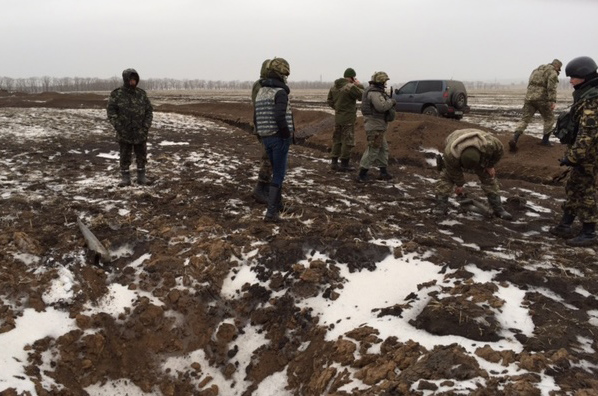 Luhansk Oblast – Ukrainians are waiting for war to start again. Since a ceasefire agreement went into effect in February, the winter has been relatively quiet in Luhansk Oblast, marred only by sporadic rockets fired from the territory of the so-called Luhansk People’s Republic (LNR). In many respects, life appears oddly normal in the small towns and villages along the border of the LNR and Ukrainian-controlled Luhansk.Parents walk with their children along the narrow roads, grocery stores are open, and there is the occasional group of teenagers smoking and loitering around bus stops. But these normal scenes are jarringly interrupted by handwritten warning signs. “Danger, do not walk here,” written in bright red letters hangs on one school building in a village outside of Sievierodonetsk. Fresh shelling sites from missiles fired by Russian-backed separatists are just a few miles away from the normalcy of small city life.
Luhansk Oblast – Ukrainians are waiting for war to start again. Since a ceasefire agreement went into effect in February, the winter has been relatively quiet in Luhansk Oblast, marred only by sporadic rockets fired from the territory of the so-called Luhansk People’s Republic (LNR). In many respects, life appears oddly normal in the small towns and villages along the border of the LNR and Ukrainian-controlled Luhansk.Parents walk with their children along the narrow roads, grocery stores are open, and there is the occasional group of teenagers smoking and loitering around bus stops. But these normal scenes are jarringly interrupted by handwritten warning signs. “Danger, do not walk here,” written in bright red letters hangs on one school building in a village outside of Sievierodonetsk. Fresh shelling sites from missiles fired by Russian-backed separatists are just a few miles away from the normalcy of small city life.
But the locals know that this uneasy peace can soon yield something much worse. The Minsk II ceasefire agreement did not produce a stable ceasefire, but at least it helped to usher in a relative lull in the fighting. Russian military convoys pour into Ukraine on a daily basis with weapons, supplies, and soldiers. In Luhansk Oblast and elsewhere across Ukraine, people are bracing for the next Russian attack.
Representatives from the Atlantic Council visited the frontline of the area that Ukraine calls the “ATO zone,” for “Anti-Terrorist Operation,” on March 30, just two days after LNR forces had fired a barrage of Grad rockets into Ukrainian-controlled territory. We observed the damage: The missiles left three-foot wide craters on the flat landscape, covered in a fresh layer of late-spring snow. Monitors from the Organization for Cooperation and Security in Europe (OSCE) were on the scene a few days prior. OSCE monitors mobilize quickly to collect shell fragments, which are inscribed with country-specific serial numbers that, when still visible, may provide important evidence of direct Russian military involvement in the war in Ukraine.
But to the soldiers serving on the frontline, the Russian military presence is in plain sight: they have seen the Grad shelling since the signing of the ceasefire agreement. Locals told us that they have regular interactions with Russian soldiers who, while without Russian military insignia, openly admit serving in the Russian military and following direct orders. These accounts are difficult to confirm independently—even OSCE monitors do not have full access to the separatist-controlled regions—but reports of Russian soldiers participating in the fighting are numerous.
The Atlantic Council delegation visited only the Ukrainian held parts of the front in Luhansk Oblast. We observed that the Ukrainian army lacks basic equipment. The young Ukrainian soldiers manning the checkpoints wear a mish-mash of camouflage uniforms and mismatched plated vests. According an officer in Ukraine’s Armed Forces who accompanied us but did wish to be identified, the army is still badly underequipped. “Uniforms are handmade or brought to the frontline by networks of civilian volunteer groups, who risk their lives to deliver basic supplies, from body armor to dehydrated borscht,” he told us.
There are other less obvious signs of equipment shortages: at the checkpoints, soldiers live in makeshift tents directly at the checkpoint and travel in old, unarmored cars through potentially mined fields. The car that took our team to the front was an old British jeep that somehow made its way to eastern Ukraine. But, despite the outdated equipment, the young men who greet us at the checkpoints smile as they wave us through. Many of them have regional accents from the western and central regions of the country. Now, they find themselves in Ukraine’s far east, facing the Russian army on the other side of the border, as NATO satellite imagery confirmed in August 2014.
We traveled to the frontline to document evidence of direct Russian military presence in the war in Ukraine, and we certainly found that: satellite imagery of Russian troop build-up on the border and reports from locals strongly suggest that Russia is waging a full out war in Ukraine. But what we did not expect to find was how much this war has united the Ukrainian regions that remain under government control. From the young men from western and central Ukraine who volunteer to fight to the civilian volunteers who support them, the linguistic or ethnic divisions are being subsumed by an emerging uniquely Ukrainian identity, defined by a desire to “live as free men,” as one soldier put it. The war for Ukraine’s independence is being fought now, and it is a war that reaches far beyond Ukraine’s political borders to all of Europe.
Alina Polyakova is the Associate Director of the Dinu Patriciu Eurasia Center at the Atlantic Council, where she oversees the Ukraine-in-Europe Initiative.
Image: An Atlantic Council delegation on March 30 inspected the damage wrought by Grad rocks fired by Russian-backed separatists in Luhansk Oblast. (Atlantic Council)
